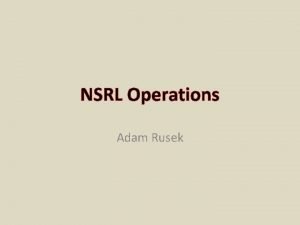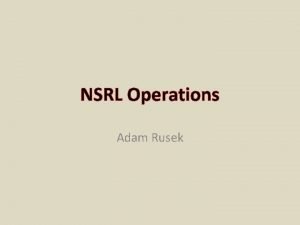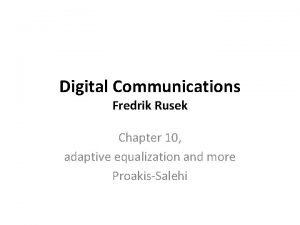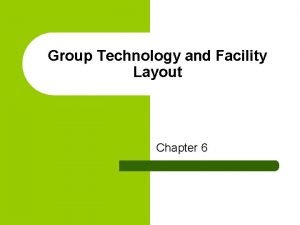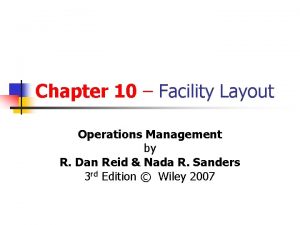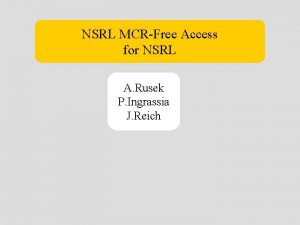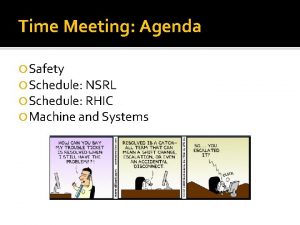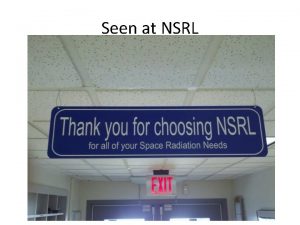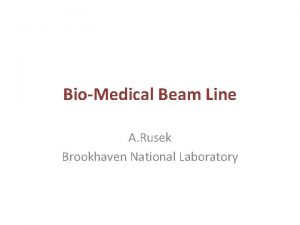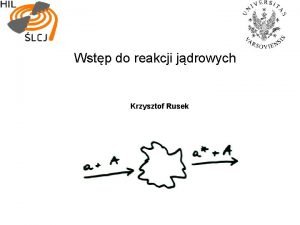NSRL Operations Adam Rusek The Group Adam Rusek











- Slides: 11

NSRL Operations Adam Rusek

The Group • • • Adam Rusek – Principal Investigator, Dosimetry, Physics, User Support Mike Sivertz – Deputy, Dosimetry, Physics, User Support Chiara La Tessa – Dosimetry, Physics, User Support I-Hung Chiang – Dosimetry, Physics, User Support Charlie Pearson – Engineering, User Support, Facility Management • • I-Hung has gone to 75% Adam is now 75% NSRL, 25% C-AD

Work for Others • 60 hours, privately funded • We haven’t seen or heard from the NRO all year. • We do expect to start receiving applications for beam time from NIH/NCI and Texas funded researchers, in connection with the cancer therapy effort in Dallas.

NSRL-15 • I was hands-off. Chiara and Mike did fine. • Mostly routine work. • We did quite a bit of light ion survival and cross section work (results presented here at HRP meeting, and being prepared for publication) • Support from Bioscience continues to be very good • Support from BLAF was good, to be taken a step further starting 2016 (see P. Guida’s report) • The trend we are seeing is less beam time used, and more beam preparation time during off hours. A good fraction of the beam development time was taken up by GCRSim developments, which is hard to separate from ordinary preparation. Perhaps some of those hours should be charged to the Controls portion of the GCRSim project.

EBIS • LIS/EBIS did very well this past year, the GCR control tools proving useful in day to day operations. Working with several ions per day has been achieved several times, and will be “routine” in 2016, that is, if needed, we will accommodate users who need multiple ions in one day. We are not yet confident enough to encourage it… • We are the users who work the closest with the EBIS crew, are most familiar with their capabilities and limitations, and represent the largest impact on their schedule at times. We are considering becoming involved with their operations at some low level, that is, learning how to shut things off in the evenings or nights, so they don’t have to keep people on late shifts.

Beam Line • The beam line was resurveyed (no significant movement in 14 years), and inspected for any aging, wear and tear, leaks, etc. . There were some findings which were dealt with this past summer: – Water leak in one of the coils of the Q 8 magnet – coil replaced. – Water leak in the water-cooled bus to Q 9/10, probably there since first installed – repaired. – The 158 instrumentation package was installed off center. It took this long to know that for sure (how can you tell the device you make position measurements with is not in place? ) – repositioned. – The beam plug drive mechanism was overhauled and is now working very smoothly. – All the supply and return water hoses on the magnets were aging – replaced with higher quality hoses and connectors.

Power Supplies • • • Power supply controller spares continue to be a concern. It turns out that it is not so straightforward to obtain the boards we need. We are on this issue continuously. Other spare parts, such as spare polarity switches, coils etc. , are in hand, and easier to obtain, in general. As I have said in the past, wear and tear on the NSRL beam line is in moving parts and power supply electronics. The next place we may see aging related problems will be the cooling water system (heat exchangers, cooling tower) for the Booster. There is no plan for it yet, but it is an old system and the expense of replacing it will be shared (just proactively reacting to issues).

Facility • General up keep of the building and target room – continuing effort. – Countertop repairs, paint touchups, vacuum outlets, waterline rerouting, etc…. – New target room cameras, new, self leveling alignment lasers, target room gadgetry, etc…. • • Chemical hoods placed on a system of counter tops and shelves on the wall where the distiller was mounted. The water purification system is in place, still needing to be hooked up. A new bottle-filling station was installed in the animal side, designed to fill 16 bottles t a time. Using house water requires filtering, so, A house water filter is being installed.

Developments • New Readout System – Working on developing a stand-alone windows-based readout using the first readout system we got from Sens. Tech. This system has a dynamic range which exceeds even the Berkeley-built readout we use routinely, and will make a very good traveling, cross-calibration readout. We are planning to build a self contained power supply and readout system, which will eliminate grounding problems which often plague ion-chamber measurements in the field. • PETRA – Is now part of the verification process. Documents against which we check users’ ion/energy/dose protocols are obtained through PETRA, and permanent records which cannot be further edited are automatically created and kept in the process. – http: //dev. bnl. gov/nsrl/

Following this summer’s occurrence • • • We are not completely out of the woods: DOE will have a walkthrough focused on our response to the protocol violation from this past summer, and our new safeguards against repeats. We are in the process of revising the new procedures, having received comments on the clarity and correctness of the documents. I believe we have until July to complete this task. The system we put in place has been accepted as a well conceived and executed response to the committee’s recommendations. Our response to the event was quick and effective for the following reasons: – While we were blindsided and caught off-guard, there were enough people informed on the issue in management who helped guide us in an way that protected our program. – Derek mandated the IACUC summary process which Peter’s group carries out, and which was available and accepted, immediately following the event, as a record against which we can check the user’s ion/dose request. Kudos, Derek… – PETRA was available almost immediately, with modifications implemented within a day or so, as a process control point, data entry and record keeping mechanism. – Early on, and eventually throughout the longwinded ordeal, not once did I get the sense that anyone was hostile towards our program. There was a genuine interest in getting the program back on track, with research at the focus. “I’d much rather be lucky than good” C. Pearson

New Web Page • • https: //www. bnl. gov/nsrl/ Check it out
